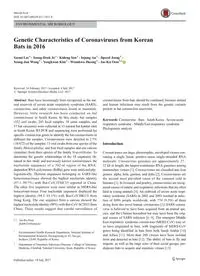
2017 Genetic Characteristics of Coronaviruses from Korean Bats in 2016 PDF
Preview 2017 Genetic Characteristics of Coronaviruses from Korean Bats in 2016
ENVIRONMENTAL MICROBIOLOGY Genetic Characteristics of Coronaviruses from Korean Bats in 2016 Saemi Lee1 & Seong-Deok Jo1 & Kidong Son1 & Injung An1 & Jipseol Jeong1 & Seung-Jun Wang1 & Yongkwan Kim1 & Weonhwa Jheong1 & Jae-Ku Oem1,2 Received: 24 February 2017 /Accepted: 4 July 2017 # Springer Science+Business Media, LLC 2017 Abstract Bats have increasingly been recognized as the nat- ural reservoir of severe acute respiratory syndrome (SARS), coronavirus, and other coronaviruses found in mammals. However, little research has been conducted on bat coronaviruses in South Korea. In this study, bat samples (332 oral swabs, 245 fecal samples, 38 urine samples, and 57 bat carcasses) were collected at 33 natural bat habitat sites in South Korea. RT-PCR and sequencing were performed for specific coronavirus genes to identify the bat coronaviruses in different bat samples. Coronaviruses were detected in 2.7% (18/672) of the samples: 13 oral swabs from one species of the family Rhinolophidae, and four fecal samples and one carcass (intestine) from three species of the family Vespertiliodae. To determine the genetic relationships of the 18 sequences ob- tained in this study and previously known coronaviruses, the nucleotide sequences of a 392-nt region of the RNA- dependent RNA polymerase (RdRp) gene were analyzed phy- logenetically. Thirteen sequences belonging to SARS-like betacoronaviruses showed the highest nucleotide identity (97.1–99.7%) with Bat-CoV-JTMC15 reported in China. The other five sequences were most similar to MERS-like betacoronaviruses. Four nucleotide sequences displayed the highest identity (94.1–95.1%) with Bat-CoV-HKU5 from Hong Kong. The one sequence from a carcass showed the highest nucleotide identity (99%) with Bat-CoV-SC2013 from China. These results suggest that careful surveillance of coronaviruses from bats should be continued, because animal and human infections may result from the genetic variants present in bat coronavirus reservoirs. Keywords Coronavirus . Bats . South Korea . Severe acute respiratory syndrome . Middle East respiratory syndrome . Phylogenetic analysis Introduction Coronaviruses are large, pleomorphic, enveloped viruses con- taining a single linear, positive-sense single-stranded RNA molecule. Coronavirus genomes are approximately 27– 32 kb in length, the largest continuous RNA genomes among mammalian viruses [1]. Coronaviruses are classified into four genera: alpha, beta, gamma, and delta [2]. Coronaviruses are the second most prevalent cause of the common cold in humans [3]. In livestock and poultry, coronaviruses are recog- nized causes of enteric and respiratory infections that are often fatal in young animals [4]. An outbreak of severe acute respi- ratory syndrome (SARS) in 2002 and 2003 resulted in infec- tion of 8096 people worldwide, with 774 (9.5%) of them dying from this novel human coronavirus [5]. SARS corona- virus is believed to have been acquired from an animal spe- cies, and the Chinese horseshoe bat may have been the orig- inal source of SARS infection [6–9]. The emergent Middle East respiratory syndrome coronavirus (MERS-CoV) may al- so have originated in bats, with fragments of MERS-CoV genes being identified in bats from both Saudi Arabia [10] and Africa [11]. More than 200 viruses have been isolated from and detected in bats [12]. The ability of bats to fly and migrate, as well as the large sizes of their social groups, pre- disposes bats to acquire and maintain viruses [13]. * Jae-Ku Oem
